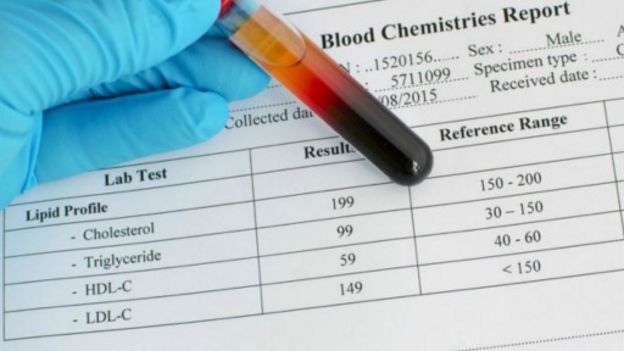研究發現:“好”膽固醇不總是都好
轉自BBC:
http://www.bbc.com/zhongwen/simp/science/2016/03/160311_good_cholesterol_not_always_good
 Image copyright Thinkstock
Image copyright Thinkstock
(吃與活注:viewfinder發現圖標的說法有誤,橄欖油,堅果,牛油果等植物中並沒有膽固醇)
一項研究發現,一些人的“好”膽固醇水平高,可能患心髒病的風險更高。
人們通常把膽固醇分為好膽固醇與壞膽固醇,好膽固醇是指高密度膽固醇(HDL),壞膽固醇則指低密度膽固醇(LDL)。
通常來說,壞膽固醇是在血管壁上的脂肪沉澱物。這種膽固醇過高可能堵塞血管,容易引發心腦血管疾病;而好膽固醇就像清道夫一樣可以帶走人體中血管中的壞膽固醇,把它交給肝髒處理,排出體外。
但是英國劍橋大學的研究人員發現,太多的好膽固醇並非總是好事。
有些食品,例如橄欖油、魚和堅果富含好膽固醇。醫生在測試病人有多大幾率犯心髒病的時候,會考慮好膽固醇的含量。
然而,研究人員發現,由於罕見的基因突變,可能會使好膽固醇水平高的人患心髒病的風險增加80%,相當於吸煙者的風險。
這種基因叫做SCARB1,影響一小部分的人,大約比例為1:1700,即每1700人當中有1人會受到影響。
 Image copyright Thinkstock
Image copyright Thinkstock
試驗顯示,正是由於發生了基因的突變,使得好膽固醇無法把收集的壞膽固醇交給肝髒處理,從而給人體帶來更大的隱患。
這一發現之所以非常重要是因為以前人們沒有想到好膽固醇也可能對人體有害, 特別是一些提升人體好膽固醇的藥物。
這也是首次研究顯示,一些體內好膽固醇水平高的人可能麵臨更大的心髒病風險。
同時,該試驗也顯示投入大量精力研製的提高人體內好膽固醇水平的藥可能沒有什麽用。
劍橋大學的巴特沃思教授說,好膽固醇顆粒的大小,以及他們運輸壞膽固醇的能力等可能更重要。
同時,研究人員說,運動既可以提高人體內的好膽固醇,也可以降低心髒病的危險。
(編譯:凱露 責編:高毅)
原始文獻:
英文介紹:
Penn Study Shows a Form of Genetically Elevated "Good" Cholesterol May Actually be Bad
Research has implications for better understanding the relationship between "good" cholesterol function – in addition to level -- and heart disease risk
PHILADELPHIA – The generally accepted medical maxim that elevated HDL cholesterol (HDL-C) is “good” has been overturned by a multi-center, international study, led by researchers from the Perelman School of Medicine at the University of Pennsylvania. They show that a certain genetic cause of increased HDL-C may actually be “bad,” noting that a specific mutation in a gene which encodes a cell receptor protein that binds to HDL prevents the receptor from functioning. The mutation causes an increased risk of coronary heart disease even in the presence of elevated levels of HDL-C or “good” cholesterol. Their findings are published this week in Science.
Rader and his colleagues sequenced the lipid-modifying regions of the genomes of 328 people with markedly elevated HDL (along with a control group with lower HDL) to identify genetic causes of high HDL. One of the genes they focused on was SCARB1, which encodes for Scavenger Receptor B1 (SR-B1), the major receptor for HDL on cell surfaces.
In the course of this sequencing, they identified, for the first time, a person without any SCARB1 function, typified by an extremely high HDL-C level of about 150 mg/dL, whereas the normal level is about 50 mg/dL. The subject had two copies of a SCARB1 mutation called P376L, which the team showed caused a breakdown in HDL receptor function.
Among the many approaches they took, the researchers generated induced pluripotent stem cells (iPSCs) from the SCARB1-deficient person, used them to create liver cells, and showed these new cells had profound reduction in their ability to take up HDL. “This mutation prevents the receptor from getting to the cell surface where it needs to be situated in order to bind and take up HDL,” Rader explained. “This disruption in the receptor’s job is due to mistakes in its folding and processing during protein synthesis.”
Going back to the other sequenced genomes, the researchers were then able to show that persons who carry only one copy of the SCARB1 P376L mutation have significantly higher HDL-C levels. From this, Rader and colleagues had a hunch, based on their knowledge of SCARB1 function and previous studies in mice, that having the SCARB1 P376L mutation, despite raising HDL, might paradoxically increase the risk of heart disease.
Working with other researchers around the world, the Penn team was able to show exactly what they had surmised. “This SCARB1 variant, while rare, is just frequent enough that it allowed us to ask the question about its effect on HDL and heart disease in people with only one copy of the mutation," Rader said.
The Penn team and their colleagues plan to characterize and test other SCARB1 mutations for their relationship to HDL levels and heart disease. Other genes may also have similar effects. “Eventually we may want to perform genetic testing in persons with high HDL to make sure they don't have mutations--like this one--that raise HDL but don't protect against, or may even increase, risk for heart disease,” Rader said. Since the P376L mutation in SCARB1 appears to be specific to people of Ashkenazi Jewish descent, testing in this ethnic group might be particularly important.
Rader suggests that a therapeutic approach to increase the expression or activity of SCARB1 could be a new way to reduce the risk of heart disease even though it would reduce HDL blood levels. “The work demonstrates that the protective effects of HDL are more dependent upon how it functions than merely how much of it is present,” Rader concluded. “We still have a lot to learn about the relationship between HDL function and heart disease risk.”
This work was led by three co-first authors in the Rader lab, postdoctoral fellow Paulo Zanoni, MD/PhD student Sumeet Khetarpal, and medical student Dan Larach.
This work was supported in part by the National Center for Research Resources (TL1RR024133), the National Center for Advancing Translational Sciences (TL1R000138), and the Doris Duke Charitable Foundation.
